Related Research Articles
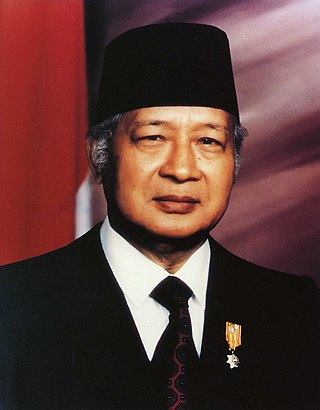
Suharto was an Indonesian military officer and politician, who served as the second and the longest serving president of Indonesia. Widely regarded as a military dictator by international observers, Suharto led Indonesia as an authoritarian regime from the fall of his predecessor Sukarno in 1967 until his resignation in 1998 following nationwide unrest. His 32-year dictatorship is considered one of the most brutal and corrupt of the 20th century.
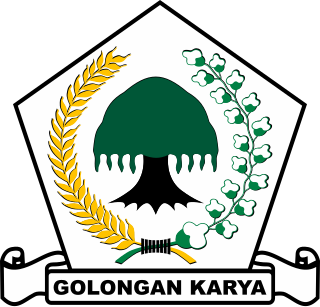
The Party of Functional Groups, often known by its abbreviation Golkar, is a centre-right big tent political party in Indonesia. It was founded as the Joint Secretariat of Functional Groups in 1964, and participated for the first time in national elections in 1971 as Functional Groups. Since 2019, it has been the second-largest party in the House of Representatives (DPR) with 85 seats. It is led by Airlangga Hartarto.
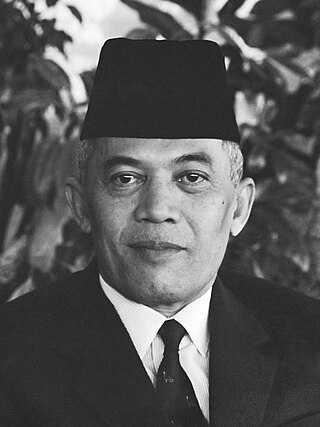
Abdul Haris Nasution was a high-ranking Indonesian general and politician. He served in the military during the Indonesian National Revolution and he remained in the military during the subsequent turmoil of the Parliamentary democracy and Guided Democracy. Following the fall of President Sukarno from power, he became the Speaker of the People's Consultative Assembly under President Suharto. Born into a Batak Muslim family, in the village of Hutapungkut, Dutch East Indies, he studied teaching and enrolled at a military academy in Bandung.

Sudharmono, also known by his nickname, Pak Dar, was an Indonesian politician and army officer, who served as the fifth vice president of Indonesia, under the New Order regime of president Suharto, serving from 1988 until 1993. Previously, he served in several positions in the government and military, including as the Chairman of Golkar, State Secretary of Indonesia, and a Lieutenant General in the army.
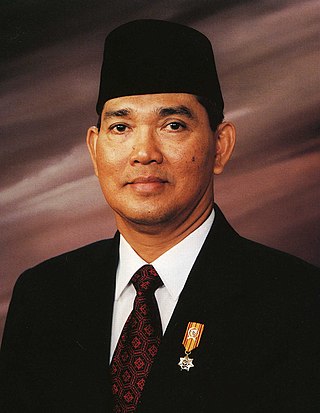
Try Sutrisno is an Indonesian retired army general who served as the sixth vice president of Indonesia from 1993 to 1998. Born in Surabaya, Dutch East Indies, Try graduated from the Army Technical Academy in 1959. During his career, Try held the positions of Chief of Staff of the Indonesian Army (1986–1988) and Commander of the Armed Forces of the Republic of Indonesia (1988–1993).

The term Government of the Republic of Indonesia can have a number of different meanings. At its widest, it can refer collectively to the three traditional branches of government – the executive branch, legislative branch and judicial branch. The term is also used colloquially to mean the executive and legislature together, as these are the branches of government responsible for day-to-day governance of the nation and lawmaking. At its narrowest, the term is used to refer to the executive branch in form of the Cabinet of Indonesia as this is the branch of government responsible for day-to-day governance.

The New Order describes the regime of the second Indonesian President Suharto from his rise to power in 1966 until his resignation in 1998. Suharto coined the term upon his accession and used it to contrast his presidency with that of his predecessor Sukarno.
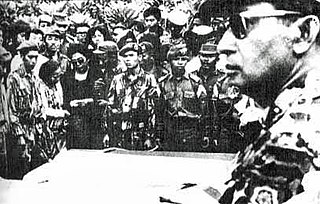
Indonesia's transition to the New Order in the mid-1960s ousted the country's first president, Sukarno, after 22 years in the position. One of the most tumultuous periods in the country's modern history, it was the commencement of Suharto's 31-year presidency.
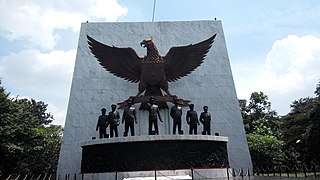
The Thirtieth of September Movement was a self-proclaimed organization of Indonesian National Armed Forces members. In the early hours of 1 October 1965, they assassinated six Indonesian Army generals in an abortive coup d'état. Later that morning, the organisation declared that it was in control of media and communication outlets and had taken President Sukarno under its protection. By the end of the day, the coup attempt had failed in Jakarta. Meanwhile, in central Java there was an attempt to take control over an army division and several cities. By the time this rebellion was put down, two more senior officers were dead.
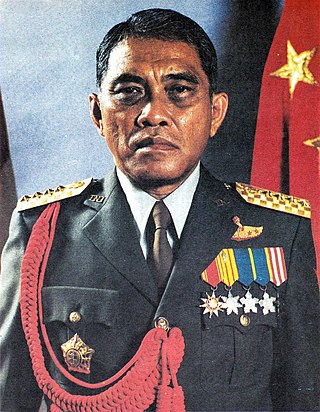
General (Ret.) Leonardus Benjamin Moerdani was the ABRI Commander from 1983 to 1988 and also served as Indonesia's Minister of Defense and Security. He is famous due to his strong stance in many decisive situations in Indonesian political and social life. He was also significant as a leader who was Catholic in a predominantly Muslim community.

The People's Consultative Assembly of the Republic of Indonesia is the legislative branch in Indonesia's political system. It is composed of the members of the House of Representatives (DPR) and the Regional Representative Council (DPD). Before 2004, and the amendments to the 1945 Constitution, the MPR was the highest governing body in Indonesia.

Sarwo Edhie Wibowo was an Indonesian military leader and the father of Kristiani Herrawati, the former first lady of Indonesia, and the wife of President Susilo Bambang Yudhoyono and also the father of Chief of Staff Pramono Edhie Wibowo. As an army colonel, he played a direct role in directing troops during the Indonesian killings of 1965–66, in which more than half a million Indonesian civilians died. With Suharto's blessing, Wibowo initiated the slaughter. Later, he served as Chairman of the BP-7 center, as Indonesia's ambassador to South Korea, and as governor of the Indonesian Military Academy.
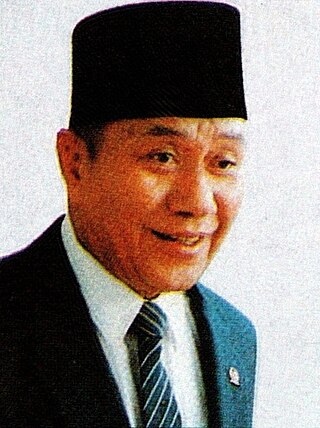
General (Ret.) Amir Machmud was an Indonesian military general who was an eyewitness to the signing of the Supersemar document transferring power from President Sukarno to General Suharto.

Hartono Rekso Dharsono, often known as HR Dharsono, was a prominent general in the early years of General Suharto's New Order regime. He served as the first secretary-general of ASEAN. In his later years, he publicly opposed Suharto.

The Sixth Development Cabinet was the Indonesian cabinet which served under President Suharto and Vice President Try Sutrisno from March 1993 until March 1998. The Cabinet was formed after Suharto was elected to a 6th term as President by the People's Consultative Assembly (MPR).

The Third Development Cabinet is the name of the cabinet of the Indonesian government led by President Suharto and Vice President Adam Malik. The cabinet was announced on 29 March 1978 and served from 31 March 1978 until 16 March 1983.

The First Development Cabinet is the name of the cabinet of the Indonesian government led by President Suharto. This cabinet was announced on 6 June 1968 and served from 10 June 1968 until 27 March 1973. The composition of this cabinet is not much different from the composition of ministers in the Revised Ampera Cabinet. Shortly after the 1971 election, on 9 September 1971, President Suharto announced a reshuffle of the First Development Cabinet and appointed the reshuffled ministers on 11 September 1971.
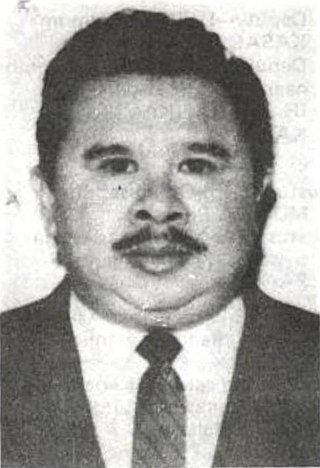
Sumitro or Soemitro was a prominent Indonesian general in the early years of General Suharto's New Order before suddenly falling from grace in January 1974 after the Malari incident.

Legislative elections were held in Indonesia on 3 July 1971, the first under the New Order regime. There were ten participants; nine political parties and the "functional group" Golkar, which came first with more than 60 percent of the vote, resulting in an absolute majority in the People's Representative Council.
The Petition of Fifty was a document protesting then President Suharto's use of state philosophy Pancasila against political opponents. Issued on 5 May 1980 as an "Expression of Concern", it was signed by fifty prominent Indonesians including former Army Chief of Staff Nasution, former Jakarta governor Ali Sadikin and former prime ministers Burhanuddin Harahap and Mohammad Natsir.
References
- Cribb, Robert; Kahin, Audrey (2004). Historical Dictionary of Indonesia. Scarecrow Press Inc. ISBN 978-0-8108-4935-8.
- McDonald, Hamish (1980). Suharto's Indonesia. Melbourne: Fontana. ISBN 0-00-635721-0.
- Ricklefs, M. C. (1991). A History of Modern Indonesia since c.1300, Second Edition. MacMillan. ISBN 0-333-57690-X.